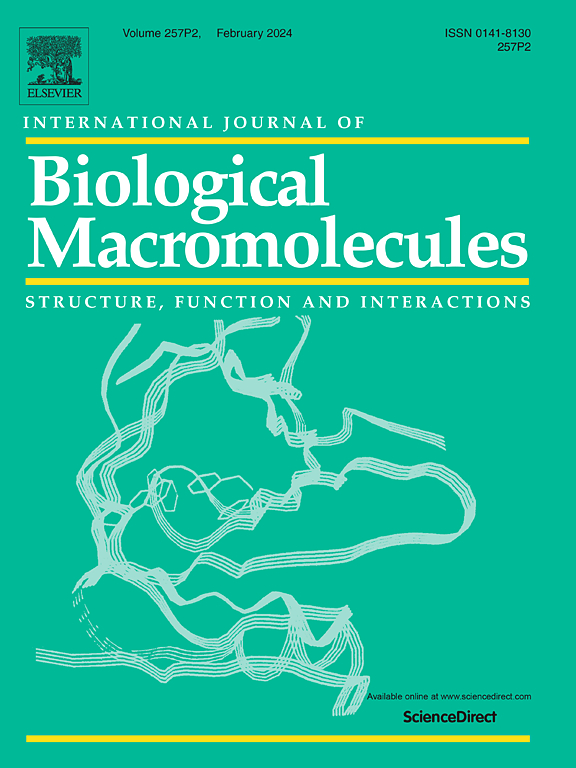Fe3O4/MethylCellulose@Pb非均相fenton型光降解染料催化剂的合成与表征
IF 7.7
1区 化学
Q1 BIOCHEMISTRY & MOLECULAR BIOLOGY
International Journal of Biological Macromolecules
Pub Date : 2025-07-12
DOI:10.1016/j.ijbiomac.2025.145966
引用次数: 0
摘要
随着工业的发展,水资源出现了严重的污染。这对生物的健康和环境造成了严重的问题。为了实现可持续发展的未来,在废水处理中生产有效、低成本和可重复使用的光催化剂是很重要的。本研究首次合成了Fe3O4/MetCel@Pb光催化剂。采用傅里叶变换红外光谱(FTIR)、x射线衍射(XRD)、布鲁诺尔-埃米特-泰勒(BET)、紫外可见分光光度法(UV-Vis)、振动样品磁强计(VSM)、电子自旋共振(ESR)、扫描电镜(SEM)、透射电镜(TEM)和x射线光电子能谱(XPS)对Fe3O4/MetCel@Pb光催化剂的性能进行了表征。Fe3O4/MetCel@Pb光催化剂的平均粒径、比表面积、带隙能、饱和磁化强度、共振磁场和g因子分别为63.88 nm、40.59 m2 g−1、5.71 eV、24.80 emu g−1、390.15 mT和1.731。XPS分析表明,CO键、FeO键、Fe2+和Fe3+键的结合能分别为286.04、528.00、711.39和723.84 eV。此外,Fe3O4/MetCel@Pb光催化剂也首次用于染料降解。对亚甲基蓝(MB)、甲基橙(MO)、酚红(PR)、西芹素黄(AY)、溴百里酚蓝(BTB)等染料在紫外-可见光作用30 min的降解率分别为100%、96.76%、94.51%、80.81%、71.93%。在可重复使用性研究中,Fe3O4/MetCel@Pb光催化剂即使在第四个循环之后,也比第一个循环还原率为1.70%。实现了Fe3O4/MetCel@Pb光催化剂的稳定性和可重复使用性。Fe3O4/MetCel@Pb光催化剂在实际染色水样中(即使在混合基质样品中)的染料降解效率也超过90%。这证实了光催化剂是一种有效的染料降解催化剂。Fe3O4/MetCel@Pb光催化剂经济、制备简单、性能稳定,将成为去除水中工业废涂料(阳离子和阴离子染料)的有效选择。此外,使用这些光催化剂将提供简单的过程,以及时间和成本的节省。本文章由计算机程序翻译,如有差异,请以英文原文为准。

Synthesis and characterization of Fe3O4/MethylCellulose@Pb as a heterogeneous Fenton-like catalyst for photodegradation of different dyes
With the development of industry, serious pollution has emerged in water resources. This poses serious problems for the health of living things and the environment. To deliver a sustainable future, producing effective, low-cost, and reusable photocatalysts in wastewater treatment is important. In this study, Fe3O4/MetCel@Pb photocatalysts were synthesized for the first time. The properties of Fe3O4/MetCel@Pb photocatalysts were characterized by Fourier Transform Infrared Spectroscopy (FTIR), X-ray Diffraction (XRD), Brunauer-Emmett-Teller (BET), Ultraviolet-Visible Spectrophotometry (UV–Vis), Vibrating Sample Magnetometry (VSM), Electron Spin Resonance (ESR), Scanning Electron Microscopy (SEM), Transmission Electron Microscope (TEM), and X-ray Photoelectron Spectroscopy (XPS). The average particle size, surface area, band gap energy, saturation magnetization, resonance magnetic field, and g-factor values of the Fe3O4/MetCel@Pb photocatalysts measured as 63.88 nm, 40.59 m2 g−1, 5.71 eV, 24.80 emu g−1, 390.15 mT, and 1.731, respectively. XPS analysis showed signals confirming strong C![]() O bonds, Fe
O bonds, Fe![]() O bonds, Fe2+, and Fe3+ at binding energies of 286.04, 528.00, 711.39, and 723.84 eV, respectively. Also, Fe3O4/MetCel@Pb photocatalysts were used for the first time in the dye degradation. The degradation of methylene blue (MB), methyl orange (MO), phenol red (PR), alizarin yellow (AY), and bromthymol blue (BTB) dyes under ultraviolet-visible light for 30 min was determined as 100 %, 96.76 %, 94.51 %, 80.81 %, and 71.93 %, respectively. In the reusability study, Fe3O4/MetCel@Pb photocatalysts showed a reduction rate of 1.70 % compared to the first cycle even after the fourth cycle. The stability and repeated reusability of Fe3O4/MetCel@Pb photocatalysts without deformation were realized. Application of Fe3O4/MetCel@Pb photocatalysts in real dyed water samples (even in mixed matrix samples) showed over 90 % dye degradation efficiency. This confirms that the photocatalyst is an effective catalyst in dye degradation. Fe3O4/MetCel@Pb photocatalysts, which are economical, easy to prepare, and stable, will be an effective option for the removal of industrial waste paints (cationic and anionic dye) from aqueous systems. In addition, using these photocatalysts will provide ease of process, as well as time and cost savings.
O bonds, Fe2+, and Fe3+ at binding energies of 286.04, 528.00, 711.39, and 723.84 eV, respectively. Also, Fe3O4/MetCel@Pb photocatalysts were used for the first time in the dye degradation. The degradation of methylene blue (MB), methyl orange (MO), phenol red (PR), alizarin yellow (AY), and bromthymol blue (BTB) dyes under ultraviolet-visible light for 30 min was determined as 100 %, 96.76 %, 94.51 %, 80.81 %, and 71.93 %, respectively. In the reusability study, Fe3O4/MetCel@Pb photocatalysts showed a reduction rate of 1.70 % compared to the first cycle even after the fourth cycle. The stability and repeated reusability of Fe3O4/MetCel@Pb photocatalysts without deformation were realized. Application of Fe3O4/MetCel@Pb photocatalysts in real dyed water samples (even in mixed matrix samples) showed over 90 % dye degradation efficiency. This confirms that the photocatalyst is an effective catalyst in dye degradation. Fe3O4/MetCel@Pb photocatalysts, which are economical, easy to prepare, and stable, will be an effective option for the removal of industrial waste paints (cationic and anionic dye) from aqueous systems. In addition, using these photocatalysts will provide ease of process, as well as time and cost savings.
求助全文
通过发布文献求助,成功后即可免费获取论文全文。
去求助
来源期刊
CiteScore
13.70
自引率
9.80%
发文量
2728
审稿时长
64 days
期刊介绍:
The International Journal of Biological Macromolecules is a well-established international journal dedicated to research on the chemical and biological aspects of natural macromolecules. Focusing on proteins, macromolecular carbohydrates, glycoproteins, proteoglycans, lignins, biological poly-acids, and nucleic acids, the journal presents the latest findings in molecular structure, properties, biological activities, interactions, modifications, and functional properties. Papers must offer new and novel insights, encompassing related model systems, structural conformational studies, theoretical developments, and analytical techniques. Each paper is required to primarily focus on at least one named biological macromolecule, reflected in the title, abstract, and text.

 求助内容:
求助内容: 应助结果提醒方式:
应助结果提醒方式:


